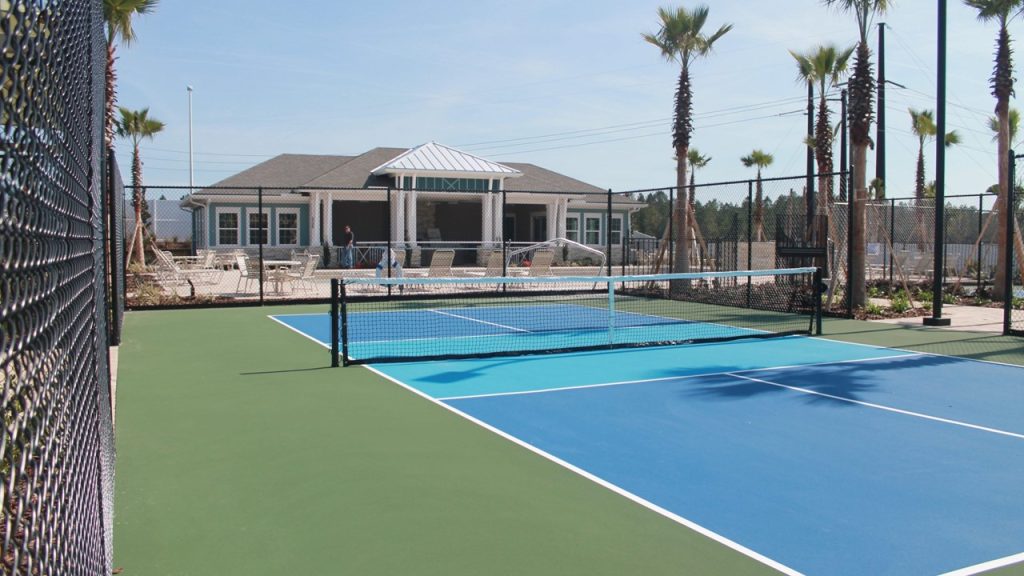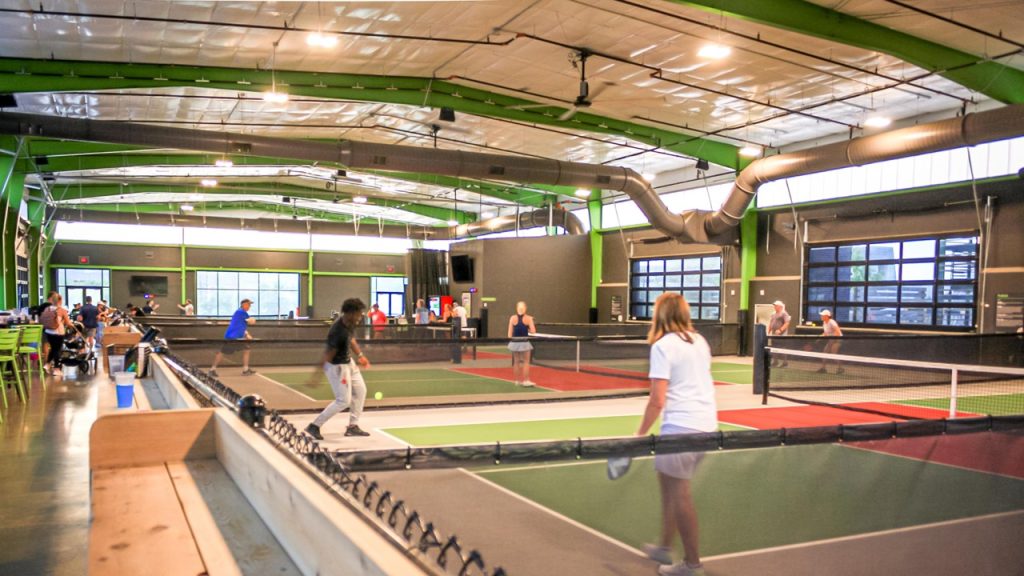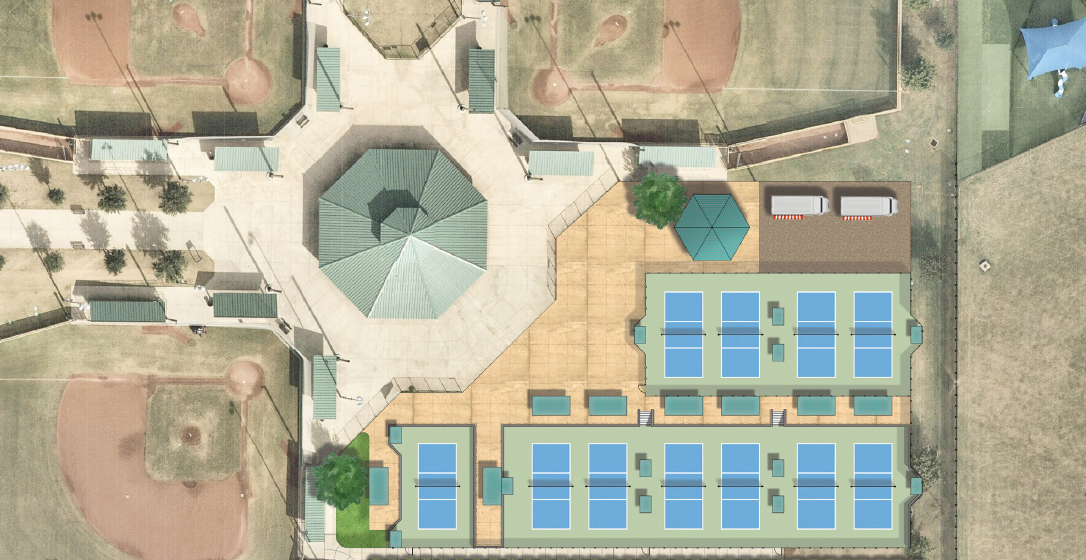Smash Hit: Learn How Investing in Pickleball Is a Wise Investment
If you’ve stopped by your community park or recreation center during the last few years, you’ve probably heard the cacophony of “thwack, thwack, thwack,” followed by comments such as, “Great dink.”
What you’re experiencing is the sound of the fastest-growing sport in North America—pickleball.
 Pickleball courts have began to appear in many places, such as the Freedom at Arbor Mill Community in Jacksonville, Fla. (Photo by Halff)
Pickleball courts have began to appear in many places, such as the Freedom at Arbor Mill Community in Jacksonville, Fla. (Photo by Halff)
History of Pickleball
Pickleball began in 1965 on Bainbridge Island, just outside of Seattle, Washington, when three dads were looking for ways to entertain their bored children. They devised a game that is a cross between ping-pong, badminton and tennis.
Played on a court roughly a quarter the size of a tennis court, the dads and their friends were immediately drawn to this new sport they created. The sport slowly grew in the Pacific Northwest until 1975 when Pickleball, Inc., began selling starter pickleball kits by mail. In 1984, the U.S. Amateur Pickleball Association, now known as USA Pickleball, was established to continue growing the sport.
Pickleball experienced steady growth until the COVID-19 pandemic hit, when it skyrocketed in popularity due to people wanting to stay active outdoors and still be socially distanced.
An Increase in Demand
According to a 2023 report by the Association of Pickleball Professionals (APP), here are the staggering numbers for pickleball participation in the United States:
-
-
-
- More than 36.5 million people have played pickleball.
- Pickleball has been the fastest-growing sport for the past three years, experiencing a 158.6% growth rate.
- The pickleball paddle market exceeds $152.8 million and is expected to have an annual growth rate of 7.7%.
- There are more than 10,300 courts located around the country.
- The top three states with the most pickleball courts are California, Florida and Texas.
- In 2021, more than half of serious picklers—those who played more than eight times a year—were over the age of 50.
- The fastest-growing participation age group is those between 18 and 34.
-
Why the Interest?
Why has the popularity increased for pickleball so quickly?
-
- The rules are simple and can be picked up quickly.
- The court is much smaller than a tennis court, so less effort is required to maneuver around it.
- The plastic, wiffle-like ball is less bouncy and travels slower.
- Paddles are smaller than tennis rackets and easier to handle.
- Serves to start the game are underhanded and much easier to return.
- Because the court is smaller, and most games are played as doubles, the game is very social because of the close proximity of the players.
- Data proves this is a multi-generational game from grandparents to school-aged kids all enjoying the fun.
- Unlike tennis, pickleball is less of a power game and more so a game of strategy.
- And finally, the game provides a great way to improve stamina and hand-eye coordination.
-
Pickleball is fun activity for individuals of all ages. Halff provided surveying, onsite civil engineering construction plans and construction phase services for the Chicken ‘n Pickle restaurant. (Photo by Halff)
Pickleball has made headway into the mainstream. Entertainment venues Chicken N Pickle and Camp Pickle are popping up across the country. Seventy countries have joined the International Pickleball Federation, and the sport is under consideration for inclusion at the 2028 Olympics in Los Angeles.
In July, pickleball courts were installed in the outfield of historic Fenway Park in Boston for a professional pickleball tournament. Frederick Law Olmstead, the father of landscape architecture, probably never envisioned that 14 pickleball courts would be constructed in New York City’s famed Central Park.
Investing in Pickleball Makes Cents
Community leaders should think about how pickleball can impact the local economy. Currently, local parks and recreation departments, homeowner associations, country clubs and fitness centers are all grappling with how to handle the demand. Pickleball facility additions can bring sports tourism to your town via tournaments and other events. Additionally, facilities help promote a healthy lifestyle for residents.
For many organizations, it is a question of real estate. A typical tennis court accommodates two players because most tennis matches are played by singles. Since four pickleball courts can fit into a tennis court and matches are more often competed as doubles, a typical tennis court space accommodates two tennis players but 16 pickleball players. The investment in pickleball provides a greater return on investment.
Communities such as Trophy Club, Texas, are now including pickleball courts in their future master plans. (Graphic by Halff)
Of course, there is one downside—the noise. The constant whacking noise when the plastic pickleball hits the paddle can be a distracting nuisance for nearby neighbors. A man in British Columbia even threatened a hunger strike over a pickleball court near his home. Strategic designs and careful placement of courts reduce this prickly issue.
Halff’s Sports Entertainment and Tourism (SET) team has experienced a significant uptick in design requests for pickleball facilities. Because of Halff’s recent pickleball research and their design experience, the SET team can apply the latest trends in pickleball design to ensure clients have a high-quality court with minimal disruptions. Investing in sports facilities, like pickleball, continues to provide an economic boost for many communities.
How Halff Can Help
Reach out to Senior Landscape Architect/Project Manager Brian Binkowski (bBinkowski@halff.com) if you have pickleball questions or are interested in developing your own pickleball facility. Or send us a message and contact us today!





